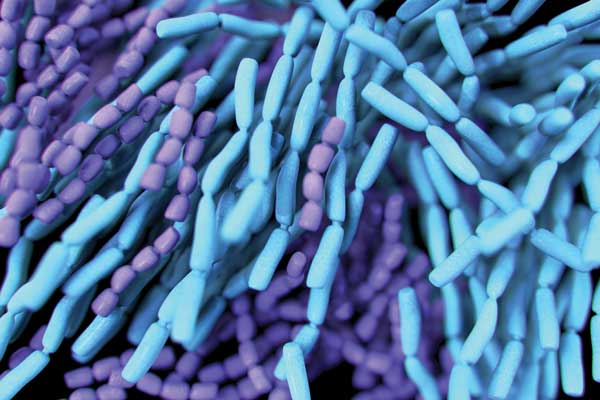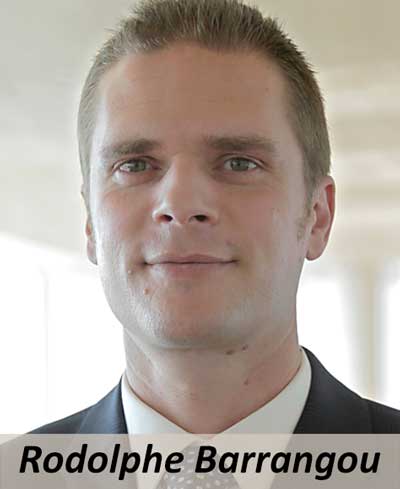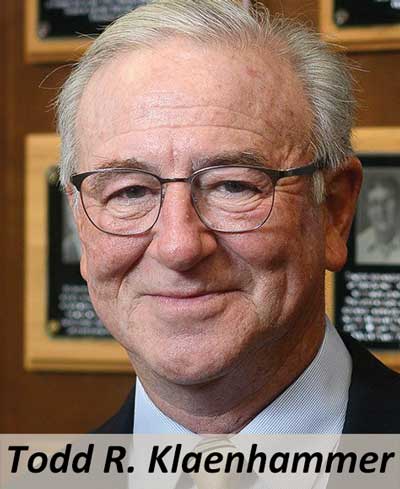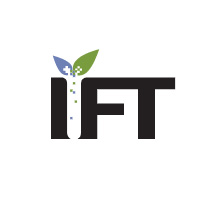
Unlocking the Genomics of Lactic Acid Bacteria
Leading food science researchers discuss advances in lactic acid bacteria, probiotics, fermentation, and CRISPR genome editing that have transformed the fermented foods industry.
For many centuries, fermented foods like cheese, yogurt, kefir, sausage and sourdough bread have relied on lactic acid bacteria for their flavor, nutrition, texture and shelf life. The art of fermentation has now become a science through microbiological analysis of starter cultures, bioprocessing technologies and, most recently, genomic sequencing of lactic acid bacteria. These technological advances have dramatically improved the stability of the fermentation process and yielded insights into the probiotic properties of fermented foods and their interaction with the human gut and microbiome. CRISPR gene editing provides new tools for creating improved starter cultures and is a critical element for a systems biology approach to understanding fermented foods and food microbiology.
Recently, E. Allen Foegeding, William Neal Reynolds Distinguished Professor in the Department of Food, Bioprocessing and Nutrition Sciences at North Carolina State University (NCSU), had the opportunity to interview two preeminent researchers—Todd R. Klaenhammer, Distinguished University Professor and William Neal Reynolds Distinguished Professor Emeritus of Food Science, Microbiology and Genetics at North Carolina State University, and Rodolphe Barrangou, Professor of Food Science and the Todd R. Klaenhammer Distinguished Scholar in Probiotics Research at North Carolina State University—about their work in lactic acid bacteria, probiotics, fermentation, and CRISPR.
 Foegeding: Can you both provide some background on yourselves and how you came to work on lactic acid bacteria?
Foegeding: Can you both provide some background on yourselves and how you came to work on lactic acid bacteria?
Klaenhammer: I came to NCSU in 1978 from the University of Minnesota as an assistant professor. In 2017, I formally retired after 39 years of service. Our group here at North Carolina State University pioneered genomic applications for food microbiology, specifically lactic acid bacteria, some of which are probiotics.
I was very honored to be the first food scientist elected to the National Academy of Sciences. In 2018, Rodolphe was also elected to the National Academy of Sciences, recognizing his work in microbial sciences and genetics—that’s really great for NCSU and for the Food Sciences nationally, as well.
I am very proud of the fact that our research program was awarded with the highest research awards presented by the American Dairy Science Association, Institute of Food Technologists, and International Dairy Federation.
Barrangou: I am the inaugural and today the only Todd R. Klaenhammer Distinguished Professor in Probiotics Research here at N.C. State University. I was born and raised in France and attended NCSU as a student, where I fell in love with bacteria in general and food bacteria—the good guys more than the bad guys—used in the food supply chain.
And then I took some of that knowledge into industry. I worked at DuPont for almost one decade on technologies to produce starter cultures and probiotics, and then came back home to N.C. State. In the last six years, I’ve had the privilege to continue and extend the tremendous legacy that we have here in the program to work on probiotics and dairy bacteria and advance our knowledge of scientific understanding of food microbiology, develop technologies that are relevant to product development, and work intimately with industry to bring some of that knowledge and technology into the real world and the food supply chain.
Foegeding: Probiotics are in the news today. Ostensibly, I can buy a pill that says this is all the probiotics I need. Can you contrast using these lactic acid bacteria to ferment lactose with probiotic activity?
Klaenhammer: Fermentation processes convert milk to yogurt and cheese. In those products, we eat large amounts of lactic acid bacteria every time we eat these fermented dairy products.
 The probiotic field developed because some lactic acid bacteria are believed and shown to have health benefits. The fermentation industry has developed through the years to be able to grow these bacteria to extremely high levels, concentrate them up to high numbers (a billion per gram), preserve them by freezing or by freeze-drying, and then deliver them in foods like yogurt.
The probiotic field developed because some lactic acid bacteria are believed and shown to have health benefits. The fermentation industry has developed through the years to be able to grow these bacteria to extremely high levels, concentrate them up to high numbers (a billion per gram), preserve them by freezing or by freeze-drying, and then deliver them in foods like yogurt.
But probiotics aren’t used to ferment the yogurt. They’re actually added as a supplement to the yogurt after fermentation. Concentrated fermentation and preservation technologies allow us to create dietary supplements, a pill if you will, to deliver these bacteria at high levels.
When you eat these probiotics in foods or dietary supplements, you’re eating upwards of a 100 million probiotic bacteria per gram. That number of bacteria passing through your mouth and stomach and delivered to your small intestine will overwhelm the bacteria that are naturally present there. Flooding your GI tract with these bacteria is going to have an impact on the resident bacteria in the GI tract … and temporarily change the microbiome.
We also know that probiotics are not permanent colonizers. They do not persist in your GI tract after feeding stops. They’re transient passengers that go through and interact with the other bacteria there and your intestinal mucosa. The composition of your microbiota returns to your normal levels once you stop feeding probiotics.
 One of the big questions about efficacy of probiotics is can one probiotic strain do all the things that are claimed as health benefits? How do they do something to the immune system? How do they kill a pathogen? And all probiotic bacteria are not the same, and all targets for probiotic health benefits are not the same. So, one can easily imagine multifaceted, multi-strain cultures, if you will, probiotics that have multiple targets or to use a particular kind of probiotic supplement or food to attack a particular target for health and well-being. So, I’m a big proponent of eat bacteria and get cultured.
One of the big questions about efficacy of probiotics is can one probiotic strain do all the things that are claimed as health benefits? How do they do something to the immune system? How do they kill a pathogen? And all probiotic bacteria are not the same, and all targets for probiotic health benefits are not the same. So, one can easily imagine multifaceted, multi-strain cultures, if you will, probiotics that have multiple targets or to use a particular kind of probiotic supplement or food to attack a particular target for health and well-being. So, I’m a big proponent of eat bacteria and get cultured.
Foegeding: How has the research in lactic acid bacteria and probiotics changed over the years?
Klaenhammer: I started in 1973 at the University of Minnesota working with Professor Larry McKay. At that time, Stanley Falkow had just discovered that plasmid DNA was responsible for the transmission and dissemination of antibiotic resistance in pathogens. McKay discovered plasmids in lactic acid bacteria and was trying to understand if these extrachromosomal elements impacted the stability and efficiency of starter cultures used in dairy fermentations.
The literature showed that the fermentation behavior was unstable and sporadic. Lactic acid bacteria would spontaneously lose the ability to ferment lactose, which is a very important part of milk fermentation. They would also spontaneously lose proteolytic activity and the ability to coagulate milk, essential to milk and cheese fermentations.
These unstable fermentation characteristics were problematic, but not understood. The industry was trying to figure out how to control this. Larry’s hypothesis was that plasmids were responsible for the genetic instability of those essential fermentation traits. He showed very specifically that when lactose fermentation disappeared from the culture, that particular culture lost a particular plasmid. And went on to show that plasmids are responsible for citric fermentation, bacteriocin production, proteolytic fermentation, and lactose fermentation.
That was the first time anyone in food microbiology took a genetic approach to try and solve a practical food microbiology problem. And it exploded the fields of food safety, food bioprocessing and fermentation—and taking a genetic approach was very important to understanding food pathogens and controlling fermentation bioprocessing.
At that point, the field exploded from plasmids, to one gene one property, enterotoxins in food pathogens, lactose fermentation for bioprocessing, bacteriocin production and then into genomics. When we published the genome of Lactobacillus acidophilus in 2005, Rodolphe was part of this team, it cost us $2.5 million. Today, sequencing for a strain isolated will take a week and cost about $1,000. So, the technology of having a genetic perspective has gone from a very long, complicated and difficult road to having a complete annotated DNA sequence of plasmids and chromosomes of multiple bacteria on your desk in a week.
Foegeding: If I can paraphrase, you were there at the beginning of doing molecular genetics and linking that to phenotypical traits of importance to the food industry and have rode that wave for three decades.
Klaenhammer: Four decades.
Foegeding: And then Rodolphe, you came along and were catching the first wave, in fact, you’re one of the first to board on the wave of the CRISPR craze that’s going on now. Can you please tell us about your role in CRISPR?
 Barrangou: CRISPR is currently one of the most popular, compelling, and visible technologies across all of science. It is a very powerful technology used to do genome editing, and in the last few years, approximately one million geneticists across the globe have been able to use CRISPR- based tools to alter the genetic content of hundreds of species of relevance to the food, agriculture, medical, and biotechnology industries.
Barrangou: CRISPR is currently one of the most popular, compelling, and visible technologies across all of science. It is a very powerful technology used to do genome editing, and in the last few years, approximately one million geneticists across the globe have been able to use CRISPR- based tools to alter the genetic content of hundreds of species of relevance to the food, agriculture, medical, and biotechnology industries.
What’s interesting is that this technology, this CRISPR-based technology and tools that are derived from it, actually have an original birthing story from the food industry. About 10 years ago, I was involved in a piece of research that laid the foundation for understanding what CRISPR is and how it works.
CRISPR stands for Clustered Regularly Interspaced Short Palindromic Repeats. It’s a mouthful to describe the peculiar and idiosyncratic piece of DNA that is made of repeated elements interspersed with pieces of DNA that are picked up from viruses. That’s what CRISPR is. What it does is constitute the adaptive immune system in bacteria. So, very much like we humans get vaccinated over time, preferably at the doctors but sometimes naturally, based on a mechanism of antibody antigen protein–protein interaction. CRISPR is the equivalent of these antibody–antigen interactions for immunity, not in humans, in bacteria.
CRISPR is DNA encoded for DNA targeted immunity, whereby the CRISPR system in bacteria will capture the piece of DNA from an invasive virus, integrated it into the CRISPR and use it to search and recognize invasive genetic elements. If it finds a match, think of CTRL-F in a Word document, that has the same sequence, the same string of letters or DNA code, then it will cleave it.
The way we applied this to food bacteria was by solving a very basic problem. In the food industry, many starter cultures, if not most starter cultures, are subjected to viral predation by bacterial viruses called bacteriophage that essentially kills them. It’s a natural and ubiquitous phenomenon that occurs across the globe.
At DuPont we were trying to understand why some bacteria withstand phage attack. We had some offspring of some very popular starter cultures they put in yogurt and cheese that had become resistant over time to certain phages. And the “eureka” moment was that when we sequenced the genomes of the offspring, the CRISPR was different than that of the parent, and the difference in the CRISPR was the acquisition of a piece of extra DNA, and because we were sequencing a lot of things at the time, including the viruses as well, we could see that the pieces of virus were constituting the piece of DNA that was acquired into the CRISPR.
We embarked on a series of experiments for the first few years of my career at DuPont trying to show, and we did show, that essentially CRISPR acquires pieces of DNA from viruses, that it builds immunity against phages, and that that it works by cutting DNA. What some people did thereafter is use those molecular scissors to cut any DNA, like human DNA or plant DNA or other DNA, and realized that when you cut DNA you can change DNA precisely at the site of cleavage that you do CTRL-F, cut and then you can edit the text precisely at this location to perform genome editing. In the industrial world, this is a technology that has been used to generate super phage resistant bacteria now employed across the globe to manufacture and transform milk into fermented milk that is your cheese and yogurt.
Foegeding: How essential are these molecular genetic tools in making key fundamental discoveries?
 Klaenhammer: In the past, there was a process where one would take a culture, in this case let’s call it Streptococcus thermophilus, which is used in every yogurt fermentation, and they would take that culture and then treat it with whey samples from a fermentation plant. In the whey samples are the bacteriophages that have developed in the plant against that culture.
Klaenhammer: In the past, there was a process where one would take a culture, in this case let’s call it Streptococcus thermophilus, which is used in every yogurt fermentation, and they would take that culture and then treat it with whey samples from a fermentation plant. In the whey samples are the bacteriophages that have developed in the plant against that culture.
Historically, industry would make whey-derived starter cultures by adding the whey back to the starter culture. The “survivors” are naturally occurring phage-resistant bacteria. Then those survivors would be used to formulate the “whey-derived starters” for the next batch of cheese—this was an ongoing, day-to-day selection process to constantly upgrade the starter cultures for phage resistance.
What Rodolphe’s group did after discovering CRISPR was to use an adaptive immunity approach based on a strategy … “Well, if I’ve got this virus and I’ve got this culture, I can intentionally attack that culture, and isolate survivors”. They looked at the survivors and saw the ones that were resistant to the phage and showed they had picked up a small piece of that phage DNA in the CRISPR array. And that’s what allowed them to be resistant.
My point here is that historically this went on naturally by microbiologists and dairy technologists and Rodolphe’s group put it together to say, “Now, we can intentionally adapt bacteria to be resistant to this virus, isolate the derivative, and make cheese.” And if you did that sequentially with a variety of different viruses, they end up with a longer CRISPR array with a piece of each of these viruses’ DNA rendering them immune.
Foegeding: So we were doing fermentation but never really understood what we were doing until we got down to the molecular genetics to really understand what’s going on.
Barrangou: I think this is a great example of how the questions and the solutions are not new. You know, they are original, they are vintage, the same problems the same issues, but over time as science and technology evolve, the tools of the trade change. The ease with which, the speed with which or the cost and resources that it takes to address those challenges and solve those problems and unravel the mechanistic basis for understanding what happens in nature, that’s what changes.
And I think CRISPR is a great example of a new scientific lens, technological lens, that enables us to zoom in at one more level of magnification and understand what happens. This is how science works. Over time you will make discoveries and contributions as technologies change, and what you do is change the bottleneck. You change the limiting factor, whether it’s financial, whether it’s technical, whether it’s scientific, whether it’s resources and now you have the ability to dig deeper, or peripherally or see better or gaze in a more clear manner or change the vantage point, but it’s still the same biology.
It’s down to genotypes and phenotypic behaviors, and food fermentation is not novel. We’ve been doing food fermentations for millennia before we even knew about microbes and bacteria.
Foegeding: Rodolphe, was your discovery an “aha” moment or was it a process of building a story?
Barrangou: It was assembling a puzzle. We had different pieces of information that didn’t quite make sense at the time. We had clues, we had nuggets of gold and experience and pieces of data. And we patched them back together and we came across repeatedly, no pun intended, CRISPR clues at separate points in time and different projects, the different genomes, and different data sets.
Over time, we started asking very specific questions like what happens to the CRISPR when phage infection occurs? Then we had some “aha” moments. Ah, the CRISPR changed. And then what we did is we designed experiments to actually show that it happens that way.
Klaenhammer: This is one of the most amazingly beautiful food science stories ever told. Scientists saw CRISPR arrays all over microbiology: archaea, E. coli. We saw it in the L. acidophilus genome. Didn’t know what they were. Repeated sequences in arrays and nobody knew what they were. The fact is that this is a humble Streptococcus thermophilus bacterium used to make Italian cheeses and yogurt in huge industrial fermentations all around the world. Globally, bacterial viruses were attacking those cultures over hundreds of years and adaptive evolution for phage resistance continuously happened. This basic food fermentation system allowed CRISPR to be discovered, understood and practically realized for benefits much larger that anyone could imagine.
Food Technology Articles

Better Juice and Ingredion Collaborate and More Ingredient News
News about food industry suppliers

How to Formulate for Food Intolerances
In this column, the author describes the global prevalence of food intolerances and provides insight into state-of-science ingredient replacement and removal methods when formulating gluten-free and lactose-free foods.

Top 10 Functional Food Trends: Reinventing Wellness
Consumer health challenges, mounting interest in food as medicine, and the blurring line between foods and supplements will spawn functional food and beverage opportunities.

Keeping Chocolate Sweet While Cutting Sugar
Penn State food scientist Gregory Ziegler experiments with substituting rice flour and/or oat flour to reduce the sugar content of chocolate.

Battling Biofilms
In this column, the author describes the stages of biofilm development in food processing plants, methods of removal, and best practices for prevention.
IFT Podcasts

Episode 33: Global Food System Challenge Growth Grant Winners
Join us to celebrate the Global Food System Challenge Growth Grant Winners. Representatives from Food Systems for the Future (FSF Institute), iDE Global, and the African Center for Technology Studies discuss their work and the role that the generous funding from Seeding The Future Foundation plays in helping to make healthier diets more accessible and empowers consumers to make choices benefitting both personal and planetary health.

Episode 32: Global Food System Challenge Grand Prize Winners
Join us to celebrate the Global Food System Challenge Grand Prize Winners. Representatives from the International Rice Research Institute, Solar Freeze, and WorldFish discuss their work and the role that the generous funding from Seeding The Future Foundation plays in helping to make healthier diets more accessible and empowers consumers to make choices benefitting both personal and planetary health.
EP 7: Microalgae - Modern Uses of an Ancient Ingredient
Microalgae: Modern uses of an ancient ingredient.

